
Economic Affairs, Vol. 65, No. 4, pp. 645-51, December 2020
DOI: 10.46852/0424-2513.4.2020.22

Case Study
Farmers Perception on Climate Change and its Impact on Pigeon Pea in Mahabubnagar District of Telangana
ABSTRACT
The present study was carried out in the erstwhile Mahabubnagar district of Telangana, the major producer of pigeon pea among pulses, which lies in the rain shadow area of the state and suffers from frequent droughts. The rainfall in the district is fluctuating. Further revealed that about 70 percent of farmers expressed that change in climatic conditions has reduced pigeon pea yield and 28 percent farmers opined that it reduced output and the quality seed, 87 percent are interested in an alternate crop as a coping up mechanism in complete failure of crop. The significant change in climate as per farmer's perception is the erratic distribution of rainfall with the highest Garrett Score of 76.66, followed by a delay in monsoon,which scored 69.54. The suggestions of the farmers when ranked to face the extreme climate conditions given in the order are,the dissemination of knowledge on contingent crops,loans for second crop and waiver of earlier loans, early settlement of crop insurance, High yielding early duration pigeon pea varieties to escape terminal moisture stress, sufficient quantities of quality seed on subsidy for the second crop in case of failure of crop in initial stages.
Highlights
 The occurrence of dry spells coupled with heavy and excess rains effected the pigeon pea production.
The occurrence of dry spells coupled with heavy and excess rains effected the pigeon pea production.
 The delay in arrival of monsoon resulted in delay in sowing and terminal moisture stress and finally low productivity in pigeon pea
The delay in arrival of monsoon resulted in delay in sowing and terminal moisture stress and finally low productivity in pigeon pea
Keywords: Climate change, Draught, Erratic rainfall, Monsoon, Productivity, Pigeon pea
Climate change and its impact on agricultural production are among the most critical pressing needs in different regions of the world. Crop production and climatic factors are associated with each other in various aspects, as climatic factors are the leading cause of biotic and abiotic stresses, which have adverse effects on productivity. In recent years the consequences of climate change on crop production are a proven fact. Significant aspects of climate change are higher temperatures, changes in precipitation increase the frequency of occurrence of extreme events such as droughts, floods and cyclones, etc. which affects the crop productivity and quality, mostly visible in the rainfed crops. (Ramasamy, 2002; and Inbasekar, 2014). Though climate change is global in its occurrence and outcomes, it is the developing countries like India that face more adverse consequences (Stern, 2007).
How to cite this article: Sunandini, G.P., Shakuntala Devi, I., Sowjanya, B., Shiva Kumar, P. and Suhasini, K. (2020). Farmers Perception on Climate Change and its Impact on Pigeon Pea in Mahabubnagar District of Telangana. Economic Affairs, 65(4): 645–51.
Source of Support: None; Conflict of Interest: None 
Andhra Pradesh is considered vulnerable to climate change due to high environmental sensitivity, including the amount of safe water, percentage of managed land compared to total land, and ratio of fertilizer use to land area (Brenkert and Malone 2005). Adaptation in the agricultural sector is a crucial response, both for dealing with the impacts of droughts and long-term climate change and for ensuring progress in rural development. Adaptation means “a process by which strategies to moderate, cope with, and take advantage of the consequences of climate events are enhanced, developed and implemented” (Selvaraju et al. 2006). The changing climatic conditions have a major impact on rainfed crops including pulses (Basu et al. 2009). Pulses are reported to be particularly sensitive to heat stress at the bloom stage, only a few days exposure of high temperature can cause heavy yield losses through flower drop or pod damage (Siddique et al. 1999) Farmer's descriptions are given equal footing to scientific measurements because documenting how farmers frame the conditions they experience is crucial for understanding their responses to change in climatic conditions (Roncoli, 2006; and Tschakert, 2007).
In Telangana, pigeon pea is the major pulse crop cultivated in an area of 2.77 lakh hectares. Pigeon pea crop is grown predominantly under rain-fed conditions extensively in Kharif season only. The major pigeon pea growing districts in Telangana are Mahabubnagar, Vikarabad, Adilabad, Sangareddy, Nalgonda and Gadwal accounting for 90 per cent of the total area under this crop. The study has been taken up in erstwhile Mahabubnagar district of Telangana which is the major producer of pigeon pea occupying an area of 115 thousand hectares (2015-16) contributing 47 percent of the area in the state. The area under pigeon pea in Mahabubnagar district is on the increasing trend from 1970–71 to 2015–16 (Sangeetha et al. 2020). However, the growth in the yield is very less. The district is selected purposively for the study as Mahabubnagar is considered as rain shadow area of Telangana with a normal rainfall of 604mm (74% from South West monsoon and 20 % from North East monsoon and also the major pigeon pea producing district. The average annual rainfall in Mahabubnagar district ranged from 438.1 to 1316 mm with an average of 728.9 mm with the coefficient of variation of 29% from 1988 to 2016. The number of rainy days varied from a minimum of 34 days during 2004 to a maximum of 63 days during 2005 with annual average of 46 days for 29 years (Anil, 2017). Only 25 percent of the area is irrigated indicating that most of the area is under rainfed situation and the crop choice for farmers is limited and subjected to uncertainties of onset of monsoon, prolonged dry spells and moisture stress in the critical stages of crop. The state experienced severe drought conditions in 2015–16 affecting the productivity of the entire rainfed crop in the state. 231 out of 443 rural mandals in the state were declared as drought-affected.
All the mandals in Mahabubnagar (64), Medak (46) and Nizamabad (36) districts were declared drought-hit. Other mandals declared drought hit included 33 out of 37 in Ranga Reddy, 19 of 57 in Karimnagar, 22 of 59 in Nalgonda, and 11 of 51 in Warangal. The yields of all the crops in the state are drastically reduced. The trends in area, production and productivity of pigeon pea in Mahabubnagar district in Table 1 which showed that the area under the pigeon pea has increased from the previous years but there was no significant increase in yield
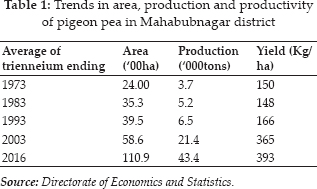
This present study focused on the perception of the farmers about the climate change and climatic conditions and its impact on crop production particularly pigeon pea.
MATERIALS AND METHODS
In Mahabubnagar, Kodangalmandal with maximum area under pigeon pea was purposively selected. From this mandal, Kodangal and Husnabad villages were selected. The data was collected through personal interview with the help of well-structured pre-tested interview schedule from 45 pigeonpea growing farmers in each village by simple random sampling technique thus making a sample of 90 farmers covering the aspects such as general farm and household characters, socioeconomic characters, perception of the farmers on climate change and impact of climatic conditions on pigeonpea productivity.
To find out major changes in climatic factors in the past four decades,the impact of climatic conditions on pigeon pea yield. Garrett's ranking technique was used. Respondents were asked to assign the rank for the climatic factors and, the outcome of such ranking was converted into score value with the help of the following formula.

Where,
Rij = Rank given for the ith variable by jth respondents
Nj = Number of variables ranked by jth respondents
RESULTS AND DISCUSSION
Cropping pattern
Pigeon pea is the major crop in the study area. Sorghum, greengram, cotton and groundnut are the other crops grown. The cropping pattern of the sample farmers presented below in Table 2 showed that the pigeon pea occupied the highest area (245.13 ha) as a sole crop.
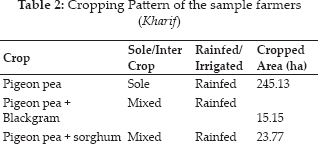

Cropping Pattern of the sample farmers (Kharif)
Frequency of drought occurrence experienced by the pigeon pea growers and impact on yield
The responses of the farmers regarding history of drought, their experience with drought, its manifestation and the visualized impact of drought on the pigeonpea productivity are recorded and the frequency of drought occurrence experienced by the pigeonpea growers in the study area is presented in Table 3. About 53 percent farmers figured that there was drought occurrence once in 2 to 3 years, while 22 percent farmers expressed that they witnessed drought once in 3–4 years. Very few, 4.44 percent farmers opined that there was drought once in 3 years, 5 years (4.44%), 4 years (5.56%). Only one farmer percent of the farmers felt that there was a drought once in 2 years. 88 percent of farmers expressed that climatic conditions were very bad during 2015–16 and 12 percent farmers told that the climatic conditions were bad. No farmer felt that the year was normal or good.
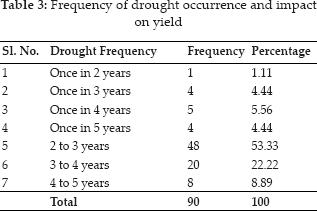
This confirmed that drought conditions prevailed once in 2 to 4 years, and a better contingency plan and precautionary measures have to be prepared to cope up with the drought conditions in the district.
Impact of drought on yield
The impact of drought on yields are discussed with farmers in the study area and presented in Table 4. 56 percent of farmers felt that during last five years 2011, 2014, 2015 are the effected years, 37 percent felt 2011 and 2015 and 8% felt that 2015 as the effected year. More than 50 percent of yield reduction was observed during 2015. During 2015–16 though the monsoon onset was in June, they have received scanty rainfall in July which affected the crop growth in the initial stages and in turn yield. Though the rainfall is good in August and September, the scanty rainfall in October and November affected the crop yield.
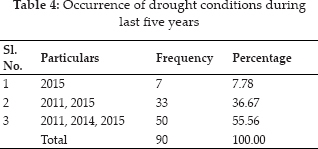
The farmers in the study area expressed the availability of water was decreasing and 97 % of the farmers are of the opinion that ground water is depleting over time. Almost all the farmers have opined that the problem of mid-season drought has increased in the past 2 decades and its effect on pigeon pea productivity as per the farmers perception is presented further.
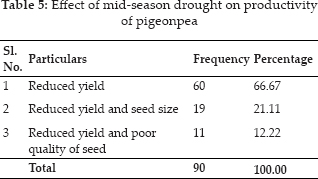
The farmers expressed (67 percent) that the mid-season drought reduced the yield of pigeonpea crop. 21 percent of farmers felt that the mid-season drought effected both yield and seed size and 12 percent farmers opined that it reduced yields and quality of the seed which is presented in Table 5. The farmers expressed the yield reduction varied from 10 to 80 percent due to drought conditions. The reduced seed size, quality and the price of produce also have come down by 10- 40 percent.
Arrival of monsoon and its impact on yield
The farmers in the study area told that arrival of monsoon was delayed, particularly in the last 7–8 years and caused problem. The delay in arrival of monsoon resulted in delay in sowing and terminal moisture stress and finally low productivity in pigeon pea. About 70 percent of farmers expressed that it has reduced pigeon pea yields and 28 percent farmers opined that it effected yield and the quality seed as presented in Table 6. The farmers expressed that there was 70–90 percent damage in case of severe moisture stress conditions in the terminal stages.
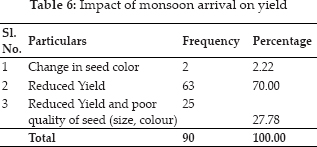
Distribution of rainfall and its impact
Majority of the farmers opined that though there is no considerable change in the quantum of rainfall during past 4 decades, wide variations are observed in distribution of rainfall. About 40 percent of farmers felt that there is no change in quantum of rainfall received, 31 percent told it is decreasing and 29 percent felt that the quantum of rainfall is increasing. However all the farmers expressed the problems of distribution of rainfall, heavy rainfall, number of rainy days. It was noted that rainfall distribution is not even and erratic after 2000. The rainfall is excess or scanty in the critical stages of the crop growth. Long dry spells are common problem. The number of rainy days as a problem was also increasing (Anil et al. 2017; and Lambrou and Nelson 2010). Though there was not much change in the total rainfall (+or -25%) the number of rainy days is decreasing resulting in heavy rain in one or two days. Occurrence of heavy rains caused waterlogging situations, wilting of crop, reduction in yields and total loss of the crop if heavy rain occurs in early stages of crop growth as told by 24 percent farmers. About 98 percent farmers experienced problem in drainage and water-logging. About 85 percent of the farmers expressed the problem of increased incidence of pests and diseases and increased expenditure. Raju et al. (2014) reported a positive impact on yield of pigeon pea was observed for a 10 mm rise in rainfall.
In the study area, Table 7 showed 57 percent farmers told that the uneven distribution of rainfall reduced the yield. 43 percent farmers opined that distribution effected both yield and quality.
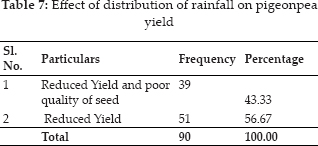
Major source of vulnerability in pigeonpea production
The study also focused in knowing the major source of vulnerability in pigeonpea production in general and presented in Table 8.
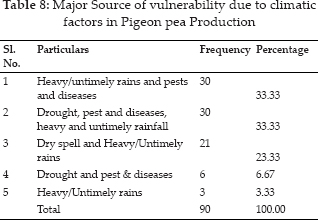
About 33 percent farmers expressed that heavy and untimely rains and pests and diseases are the major source of vulnerability in pigeonpea production (Sharma, 2014). Another 33 percent said that drought, pest and diseases, heavy and untimely rainfall in that order effected pigeonpea crop. 23 percent farmers felt that the occurrence of dry spells coupled with heavy and excess rains effected the pigeonpea production in the study area. According to 7 percent of farmers, drought, pest, diseases, Heavy/Untimely rains are the reasons for low productivity. About 3 percent of the farmers said that Heavy/Untimely rains are effecting yields severely. The farmers opined that the crop could withstand dry spells but not the excess rainfall which result in total damage to crop besides increased infestation of pests and diseases (FAO, 2016).
However, all the farmers told that drought in 201516 affected the pigeonpea crop severely and the yields are reduced drastically. Farmers expressed that pigeon pea could with stand drought but to avoid terminal moisture stress they needed early duration pigeon pea varieties with high yield potential.
Selection of crops as a drought coping up strategy and the crop choice as per the preference
In the study area, if the crop is completely damaged by drought or heavy rainfall the farmers selected alternate crops as drought coping strategy. 87 percent (78 farmers) expressed alternate crop as a coping up mechanism in complete failure of crop. Out of these, sorghum, green gram, blackgram, chickpea, safflower crops are the first choice expressed by 12.82, 6.41, 29.49, 32.05, 19.23 percent of farmers respectively as shown in Table 9.

Ranking the perception of farmer's on climate change
All farmers reported that climate change was observed over the past forty years. Farmer's perceived that average amount of rainfall during kharif (June-September) was moderate to good upto 1990s but insufficient and uneven rainfall was received after 2000. Farmers opined that though, Mahabubnagar district has a history of drought, wide variation was observed in annual rainfall received during recent years. There was increased uncertainty of effective rainfall to support crop growth in the previous 2 decades. Nearly 70 percent of farmer's observed an increase in unexpected and heavy rains. Farmer's also opined that during past decade they had seen unseasonal rains, delay in monsoon, resulting in changes in the seasons. The major climate changes observed were erratic rainfall distribution, delay in monsoon, heavy rains, long dry spells, increase in frequency of droughts, increase in temperature
The perception of the farmers on climate change as per the ranks given by the farmers were analyzed and ranked the order of the perceptions from highest to the lowest by using Garrett Ranking technique. The individual Garrett Score had been obtained for each farmer and finally average score for each perception has been calculated and the Garrett score had been presented. From the Table 10 it can be understood that the major change in climate as per farmers perception is erratic distribution of rainfall with the highest Garrett Score of 76.66, followed by delay in monsoon with a score of 69.54.
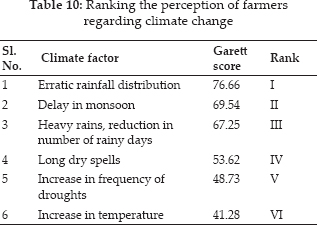
The other major changes farmers perceived are heavy rains, changes in rainy days i.e., more rain in less number of days, long dry spells, increase in frequency of drought and increase in temperature.
Ranking the suggestions of the farmers to face the extreme climate conditions
The farmers expressed that in general, deviations in the rainfall lead to low yields and insufficient income and large numbers of whole families have migrated in case of severe droughts in the 2004, 2008 and 2015. In a drought year or crop damaged year due to heavy rainfall marginal farmers obtained their food from the sources like Public Distribution System (PDS), through earnings of wage labour from Mahatma Gandhi National Rural Employment Guarantee Programme (MGNREGP). Farmers suggested the following measures are required in case of weather extremities, presented in Table 11.
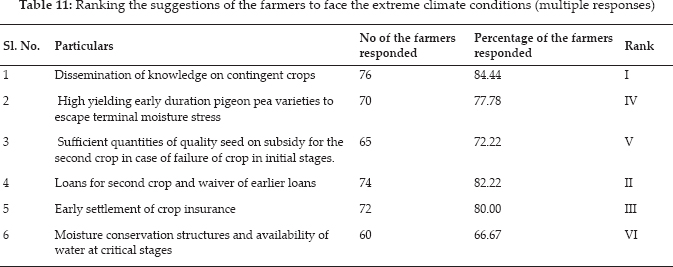
CONCLUSION
Farmers perceived that climate change was observed in the past 4 decades and the major changes are erratic rainfall distribution, delay in monsoon, heavy rains,reduction in number of rainy days, long dry spells, increase in frequency of droughts and increase in temperature in that order. Farmers opined that drought conditions occur once in 2- 4 years. Crop losses due to extreme climatic conditions ranged from 10 percent to complete failure of the crop. Major source of vulnerability in pigeon pea production as per the observations of the farmers are heavy/untimely rains, drought and pests and diseases. Farmers take second crop as coping strategy in case of complete failure of pigeon pea in the earlier stages. Farmers suggested that extension personnel should give knowledge on contingent crops in case of late onset of monsoon and crop loss in early stages. The farmers have requested for development of early duration pigeon pea variety to escape terminal moisture stress. The other suggestions include supply of quality seed, timely loans, early settlement of crop insurance claims and water conservation structures.
REFERENCES
Anil, D., Shivakumar Anna Hindhudhar Reddy K. and Pallavi Reddy, C.H. 2017. Rainfall and dry Spell analysis for Mahabubnagar district. Bulletin of Environment, Pharmacology and Life Sciences, 6(9): 42–46.
Basu, P.S., Ali, M. and Chaturvedi, S.K. 2009. Terminal heat stress adversely affects chickpea productivity in northern India- Strategies to improve thermo tolerance in the crop under climate change. ISPRS Archives XXXVIII-8/W3 Workshop Proceedings: Impact of Climate Change on Agriculture, pp. 189–193.
Brenkert, A.L. and Malone, E.L. 2005. Modeling Vulnerability and Resilience to Climate Change: A Case Study of India and Indian States. Climatic Change, 72(1-2): 57-102.
FAO. 2016. Pulses and Climate Change. International Year of Pulses. Food and Agriculture Organisation of United Nations.
Inbasekar, K. 2014. Pulses Production in India: Challenges and Strategies. Economic Affairs, 59(3): 403–414.
Lambrou, Y. and Nelson, S. 2010. FAO. Farmers in climate change, Does gender matter?, Food security in Andhra Pradesh, India.
Raju, B.M.K., Rama Rao, C.A., Rao, V.U.M., Srinivasa Rao, M. and Maheswari, M. 2014. Effect of Climate on Productivity of Pigeonpea and Cotton in Andhra Pradesh - A Panel Data Regression. Indian Journal of Dryland Agric. Res. & Dev., 29(1): 06–10.
Ramasamy, C. and Selvaraj, K.N. 2002. “Pulses, Oilseeds and coarse cereals: Why they are slow growth crops?”, Indian Journal of Agricultural Economics, 57(3).
Roncoli, C. 2006. Ethnographic and participatory approaches to research on farmers’ responses to climate predictions. Climate Research, 33: 81–99.
Sangeetha, R., Ashok, K.R. and Priyanka, P.A. 2020. Scenario of major pulse production in Tamil Nadu: A growth decomposition approach. Economic Affairs, 65(2): 301–307.
Selvaraju, R., Subbiah, A., Baas, S. and Juergens, I. 2006. Livelihood adaptation to climate variability and change in drought-prone areas of Bangladesh: Developing institutions and options. Rome, FAO.
Sharma, A. 2014. Current trends in pulse crops production: An overview. Economic Affairs, 59(4): 569–578.
Siddique, K.H.M., Loss, S.P., Regan, K.L. and Jettner, R.L. 1999. Adaptation and seed yield of cool season grain legumes in Mediterranean continents of South Western Australia. Australian Journal of Agricultural Research, 50: 75–387.
Stern, N. 2007. The Economics of Climate Change: The Stern Review. Cambridge,UK: Cambridge University Press.
Tschakert, P. 2007. Views from the vulnerable: Understanding climatic and other stressors in the Sahel. Global Environmental Change, 17(3-4): 381–396.